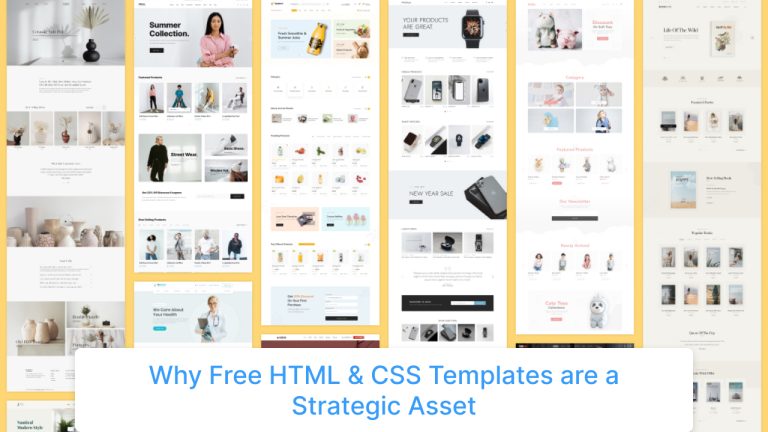Table of Contents
ToggleIn the fast-paced world of web development and digital strategy, “free” is often mistakenly equated with “low quality.” When it comes to building a website, the immediate instinct might be to commission a custom design or opt for a premium theme. However, this overlooks the immense strategic value hidden in plain sight: free HTML and CSS website templates.
For entrepreneurs, marketers, and developers, these templates are not just a cost-saving tool; they are a catalyst for speed, learning, and effective validation. Let’s dive into why they should be a key part of your strategic toolkit.
1. Speed to Market: Validate Your Idea in Days, Not Months
Time is the most scarce resource in business. Before investing thousands in a fully custom website, you need to validate your idea. A free HTML template allows you to launch a professional-looking landing page or a basic site in a matter of hours or days.
- Rapid Prototyping: Instead of waiting for a designer and developer to start from scratch, you can grab a template, customize the content, and have a functional prototype. This lets you test user interest, gather feedback, and pitch to potential stakeholders with a tangible product.
- Focus on Content: With the foundational design and code already in place, your team can focus on what truly matters at the early stages: crafting your core message, creating valuable content, and developing your product.
2. A Powerful Learning Tool for Aspiring Developers
If you or someone on your team is looking to sharpen their web development skills, there’s no better teacher than a well-written template.
- Real-World Code Exposure: Dissecting a free template is like having a seasoned developer walk you through their code. You can see how they structured the HTML for semantics, how the CSS achieves a specific layout (like Flexbox or Grid), and how JavaScript is implemented for interactivity.
- Best Practices in Action: Many reputable sources offer clean, commented code. This hands-on exploration is invaluable for understanding modern coding standards and responsive design principles far more effectively than abstract tutorials. For those ready to dive deeper, exploring open-source web components can be a fantastic next step, offering modular, reusable pieces of code that can teach you even more about scalable front-end architecture.
3. Cost-Efficiency Without Sacrificing Professionalism
The word “free” is the headline, but the real story is “smart allocation of resources.” The money saved on initial design and development can be redirected to other critical areas.
- Reallocate Your Budget: The funds you save can be pumped into marketing, content creation, software tools, or user acquisition—activities that have a more direct impact on growth in the early days.
- High-Quality Options Exist: The landscape of free templates has evolved dramatically. You can find templates with sleek, modern designs that are fully responsive and look nothing like the generic, outdated designs of the past. A quick search for Free HTML CSS website templates on dedicated platforms will reveal a surprising level of sophistication.
4. A Solid Foundation for Customization
Think of a free template not as a final product, but as a robust starting point. It’s the architectural blueprint for your house—you can still choose the paint, the furniture, and the fixtures.
- Scalable Starting Point: A good template provides a clean, organized codebase. A developer can then build upon it, adding custom features, integrating with APIs, and tailoring the design to your exact brand guidelines. This is often faster and more cost-effective than building everything from an empty text file.
- Cross-Browser Compatibility: Reputable templates are typically tested across different browsers and devices, saving you the initial headache of ensuring basic compatibility.
Choosing the Right Template: A Strategic Checklist
Not all free templates are created equal. To maximize the benefits, be strategic in your selection:
- Clean & Commented Code: Avoid templates with messy, unreadable code. Look for ones that are well-organized and include comments, making customization easier.
- Responsive Design: This is non-negotiable. Ensure the template looks great and functions perfectly on desktops, tablets, and mobile phones.
- Documentation: Does the template come with instructions or documentation? This is a sign of a quality product.
- License: Always check the license. Most are free for personal and commercial use, but it’s crucial to confirm there are no restrictions.
Conclusion: An Asset, Not a Compromise
Shifting your perspective on free HTML and CSS templates is a strategic move. They are not merely a compromise for those on a tight budget; they are a powerful asset for agile development, continuous learning, and intelligent resource allocation.
In a world where speed and adaptability are key competitive advantages, these templates provide a launchpad that allows you to move quickly, learn by doing, and invest your capital where it counts most. So, the next time you’re starting a project, look beyond the price tag and see the strategic potential of a well-chosen template.


